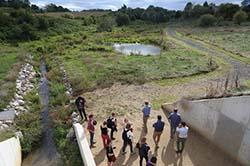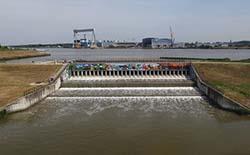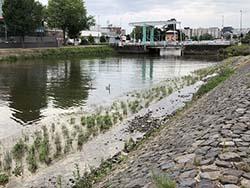
In Europe, floods are on the rise due to climate change. These extreme weather events often result in human tragedy, loss of life and economic losses. The environment also suffers with wildlife habitats being destroyed and water bodies being polluted. Several LIFE projects are working hard to alleviate the situation.
Adopted in 2007, the EU’s Floods Directive aims to curb the negative impact of flooding on human health, the economy, the environment and cultural heritage. Under the law, all EU countries must assess and map water bodies at risk of flooding. Citizens also have more of say in flood risk planning.
To mark the United Nations’ International Day for Disaster Risk Reduction, below are some LIFE projects that are all doing their bit to reduce the risk and impact of flooding across the continent.
A natural solution to flood prevention
In Europe, approximately one-fifth of the population lives within 10 km from the coast. To date, dykes or seawalls have been built to protect these areas from flooding but so-called nature-based solutions are a great alternative and becoming more common.
The LIFE ADAPTA BLUES project is showing the potential of conserving and restoring European estuaries following an ecosystem-based approach. This involves using nature’s own resources to lessen the flood risks to these coastal areas.

Becoming more ‘water aware’
Many local authorities and communities are unprepared for extreme weather events like flooding. The LIFE BEWARE project team is countering this by building sustainable urban drainage systems in the towns of Santorso and Marano Vicentino in Italy. The team is also helping introduce strategies that will help the region manage its water resources better.
Another important aspect is making the public realise that individual actions can help protect an entire community from flood risks. This involves holding training courses, conferences and webinars for residents.

Two Belgian projects work to reduce flooding and improve water quality
The Scheldt estuary in Belgium is prone to flooding, while its waters are often contaminated by industrial and agricultural activities. The LIFE BELINI Integrated Project is improving water quality and flood prevention in the Zenne, Dyle and Demer rivers. Project actions include removing fish migration barriers, building natural riverbanks, enhancing wetlands and tacking nitrate pollution.

Another Belgian project in the same area is LIFE SPARC. The project team has set out to make the Scheldt estuary and its surrounding towns more resilient to climate change. Measures include building natural areas that can safely fill with water during flooding, protecting nearby urban areas from being affected. Habitats are also being restored to make them more resilient to the effects of climate change. New green infrastructure is being developed that acts as corridors allowing species to move more freely. The team is actively engaging with the public through an information campaign. And it is promoting recreation and tourism along the estuary to boost the local economy. The LIFE SPARC project is part of a masterplan on flood prevention in the Scheldt estuary called the SigmaPlan.
Video: https://vimeo.com/345031875

Rotterdam adapts to climate change
Sustainable climate adaptation solutions can help protect cities from the devastating effects
of climate change. In Rotterdam, LIFE URBAN ADAPT is running two demonstration projects: one in the Zomerhof district and a second along the Nieuwe Maas river. In Zomerhof, actions include building new green infrastructure and adding extra water storage capacity. New green borders along the Nieuwe Maas river, meanwhile, will improve the water quality, while boosting biodiversity and flood resilience. It is expected that the project will increase the climate resilience of the two districts while restoring their ecosystems and enhancing biodiversity.

From emergency response to prevention
In Italy, recent floods and landslides have highlighted how climate change causes extreme weather events. The LIFE FRANCA project team wanted to see a shift from emergency response to one of emergency prevention, in which politicians, specialists and the public can all play a role. The team developed an online portal on flood risk which is still being used by the Service for Torrent Control of the Autonomous Province of Trento. This website is also available for residents wanting to have up-to-date information on water conditions. The results of this pilot project can be used by other regions wanting to adapt to climate change.
Stopping runoff water in its tracks
Runoff happens when there is more water than the land can absorb. The excess liquid flows across the surface of the land and can pollute nearby creeks, streams, and ponds. The goal of Spain’s LIFE DrainRain project is to reduce the negative environmental impact of this runoff on water bodies.
The project started its first pilot at the port of Ferrol in Galicia in July 2019. This is an industrial site surrounded by an area of great environmental value. The pilot plant there aims to stop the direct discharge of polluted water. The team has also started work on its second pilot, which is a sustainable drainage and treatment system for runoff water on the hard shoulder of a highway in Murcia. This second project will recover runoff water for different uses, in particular for irrigation.

Details
- Publication date
- 12 October 2020
- Author
- Executive Agency for Small and Medium-sized Enterprises

